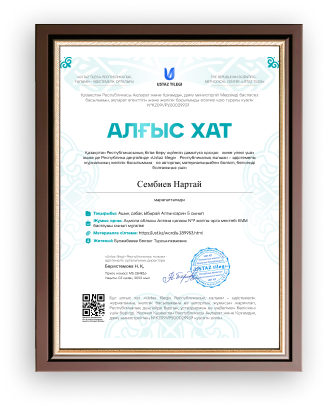Solar energy.Harnessing the Sun's energy
Solar energy.Harnessing the Sun's energy
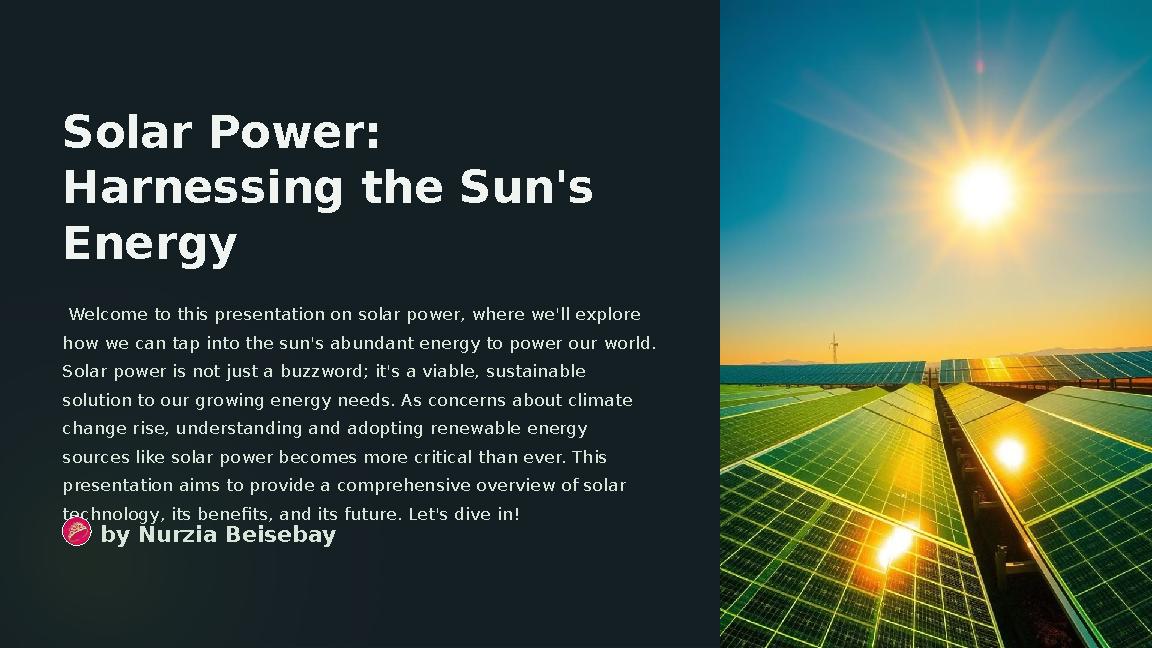

#1 слайд
Solar Power:
Harnessing the Sun's
Energy
Welcome to this presentation on solar power, where we'll explore
how we can tap into the sun's abundant energy to power our world.
Solar power is not just a buzzword; it's a viable, sustainable
solution to our growing energy needs. As concerns about climate
change rise, understanding and adopting renewable energy
sources like solar power becomes more critical than ever. This
presentation aims to provide a comprehensive overview of solar
technology, its benefits, and its future. Let's dive in!
by Nurzia Beisebay
1 слайд
Solar Power: Harnessing the Sun's Energy Welcome to this presentation on solar power, where we'll explore how we can tap into the sun's abundant energy to power our world. Solar power is not just a buzzword; it's a viable, sustainable solution to our growing energy needs. As concerns about climate change rise, understanding and adopting renewable energy sources like solar power becomes more critical than ever. This presentation aims to provide a comprehensive overview of solar technology, its benefits, and its future. Let's dive in! by Nurzia Beisebay
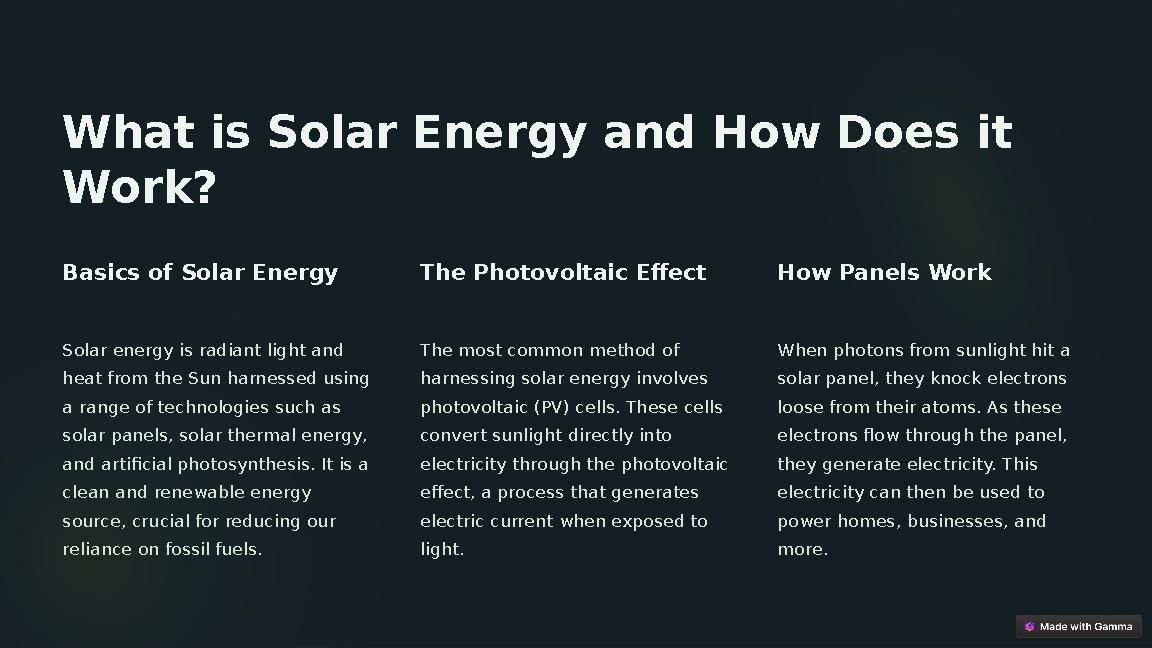
#2 слайд
What is Solar Energy and How Does it
Work?
Basics of Solar Energy
Solar energy is radiant light and
heat from the Sun harnessed using
a range of technologies such as
solar panels, solar thermal energy,
and artificial photosynthesis. It is a
clean and renewable energy
source, crucial for reducing our
reliance on fossil fuels.
The Photovoltaic Effect
The most common method of
harnessing solar energy involves
photovoltaic (PV) cells. These cells
convert sunlight directly into
electricity through the photovoltaic
effect, a process that generates
electric current when exposed to
light.
How Panels Work
When photons from sunlight hit a
solar panel, they knock electrons
loose from their atoms. As these
electrons flow through the panel,
they generate electricity. This
electricity can then be used to
power homes, businesses, and
more.
2 слайд
What is Solar Energy and How Does it Work? Basics of Solar Energy Solar energy is radiant light and heat from the Sun harnessed using a range of technologies such as solar panels, solar thermal energy, and artificial photosynthesis. It is a clean and renewable energy source, crucial for reducing our reliance on fossil fuels. The Photovoltaic Effect The most common method of harnessing solar energy involves photovoltaic (PV) cells. These cells convert sunlight directly into electricity through the photovoltaic effect, a process that generates electric current when exposed to light. How Panels Work When photons from sunlight hit a solar panel, they knock electrons loose from their atoms. As these electrons flow through the panel, they generate electricity. This electricity can then be used to power homes, businesses, and more.
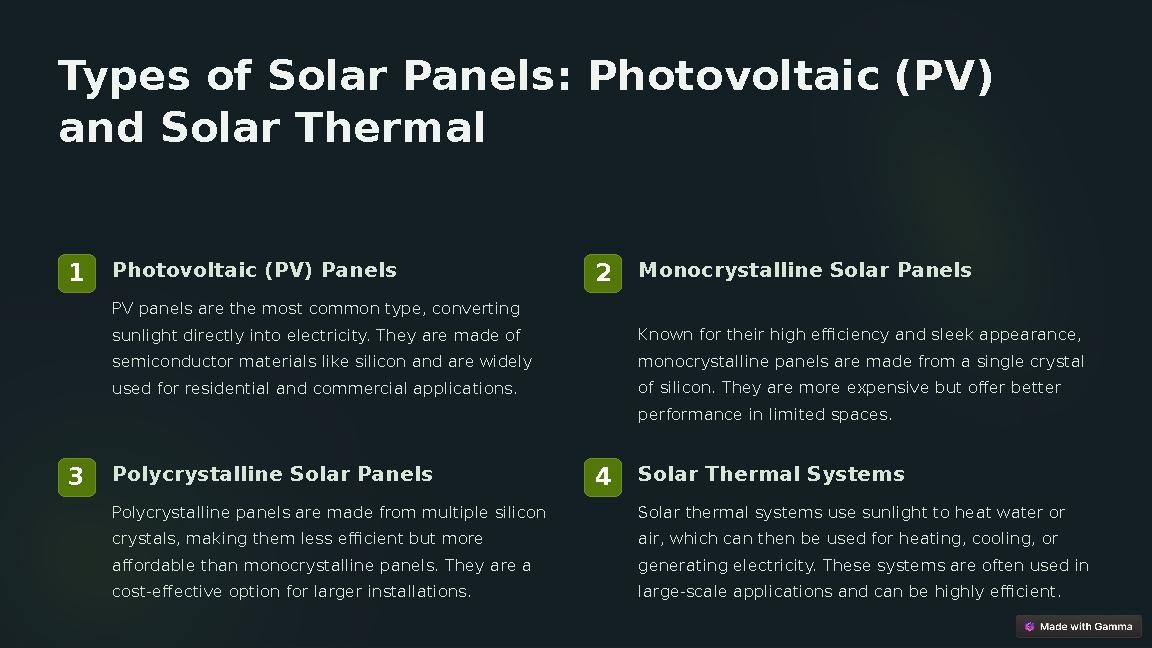
#3 слайд
Types of Solar Panels: Photovoltaic (PV)
and Solar Thermal
1Photovoltaic (PV) Panels
PV panels are the most common type, converting
sunlight directly into electricity. They are made of
semiconductor materials like silicon and are widely
used for residential and commercial applications.
2Monocrystalline Solar Panels
Known for their high efficiency and sleek appearance,
monocrystalline panels are made from a single crystal
of silicon. They are more expensive but offer better
performance in limited spaces.
3Polycrystalline Solar Panels
Polycrystalline panels are made from multiple silicon
crystals, making them less efficient but more
affordable than monocrystalline panels. They are a
cost-effective option for larger installations.
4Solar Thermal Systems
Solar thermal systems use sunlight to heat water or
air, which can then be used for heating, cooling, or
generating electricity. These systems are often used in
large-scale applications and can be highly efficient.
3 слайд
Types of Solar Panels: Photovoltaic (PV) and Solar Thermal 1Photovoltaic (PV) Panels PV panels are the most common type, converting sunlight directly into electricity. They are made of semiconductor materials like silicon and are widely used for residential and commercial applications. 2Monocrystalline Solar Panels Known for their high efficiency and sleek appearance, monocrystalline panels are made from a single crystal of silicon. They are more expensive but offer better performance in limited spaces. 3Polycrystalline Solar Panels Polycrystalline panels are made from multiple silicon crystals, making them less efficient but more affordable than monocrystalline panels. They are a cost-effective option for larger installations. 4Solar Thermal Systems Solar thermal systems use sunlight to heat water or air, which can then be used for heating, cooling, or generating electricity. These systems are often used in large-scale applications and can be highly efficient.

#4 слайд
Benefits of Solar Power:
Environmental and Economic
Environmental
Benefits
Solar power significantly
reduces greenhouse gas
emissions, combating
climate change and
improving air quality. It
decreases our dependence
on fossil fuels, promoting a
cleaner, healthier
environment.
Economic
Advantages
Solar power reduces
electricity bills, offering
long-term cost savings.
Government incentives,
such as tax credits and
rebates, can further lower
the initial investment.
Solar power also increases
property value, making
homes more attractive to
buyers.
Energy
Independence
Solar power provides
energy independence by
allowing individuals and
businesses to generate
their own electricity. This
reduces reliance on
centralized power grids
and protects against price
fluctuations and supply
disruptions.
4 слайд
Benefits of Solar Power: Environmental and Economic Environmental Benefits Solar power significantly reduces greenhouse gas emissions, combating climate change and improving air quality. It decreases our dependence on fossil fuels, promoting a cleaner, healthier environment. Economic Advantages Solar power reduces electricity bills, offering long-term cost savings. Government incentives, such as tax credits and rebates, can further lower the initial investment. Solar power also increases property value, making homes more attractive to buyers. Energy Independence Solar power provides energy independence by allowing individuals and businesses to generate their own electricity. This reduces reliance on centralized power grids and protects against price fluctuations and supply disruptions.
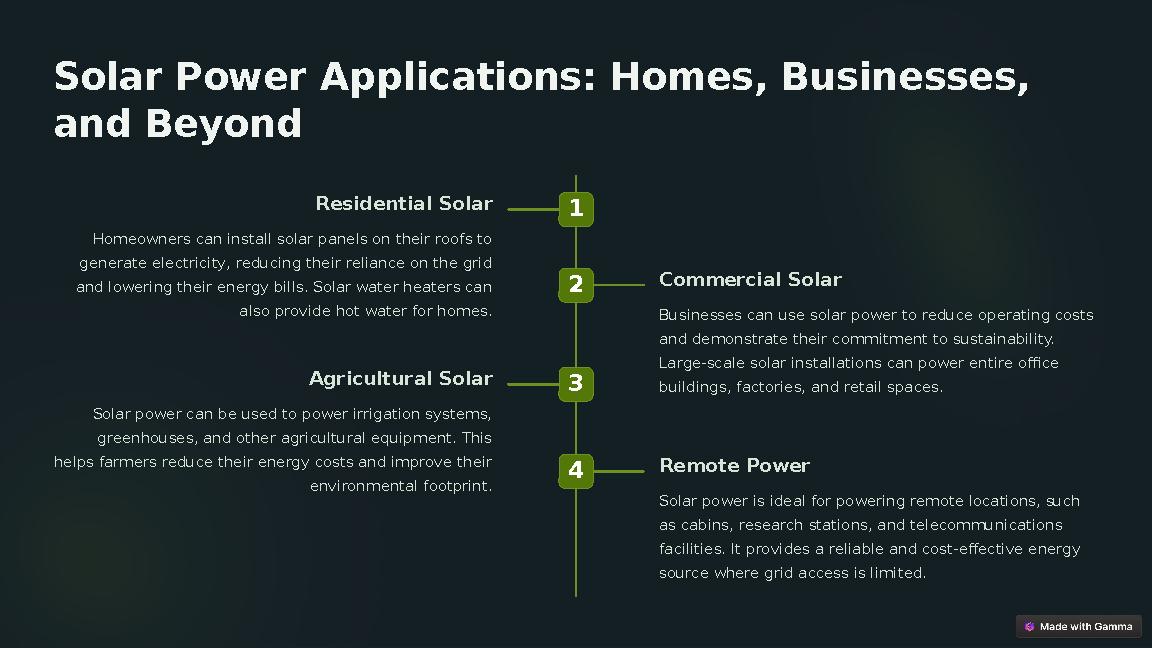
#5 слайд
Solar Power Applications: Homes, Businesses,
and Beyond
1
Residential Solar
Homeowners can install solar panels on their roofs to
generate electricity, reducing their reliance on the grid
and lowering their energy bills. Solar water heaters can
also provide hot water for homes.
2
Commercial Solar
Businesses can use solar power to reduce operating costs
and demonstrate their commitment to sustainability.
Large-scale solar installations can power entire office
buildings, factories, and retail spaces.3
Agricultural Solar
Solar power can be used to power irrigation systems,
greenhouses, and other agricultural equipment. This
helps farmers reduce their energy costs and improve their
environmental footprint.
4
Remote Power
Solar power is ideal for powering remote locations, such
as cabins, research stations, and telecommunications
facilities. It provides a reliable and cost-effective energy
source where grid access is limited.
5 слайд
Solar Power Applications: Homes, Businesses, and Beyond 1 Residential Solar Homeowners can install solar panels on their roofs to generate electricity, reducing their reliance on the grid and lowering their energy bills. Solar water heaters can also provide hot water for homes. 2 Commercial Solar Businesses can use solar power to reduce operating costs and demonstrate their commitment to sustainability. Large-scale solar installations can power entire office buildings, factories, and retail spaces.3 Agricultural Solar Solar power can be used to power irrigation systems, greenhouses, and other agricultural equipment. This helps farmers reduce their energy costs and improve their environmental footprint. 4 Remote Power Solar power is ideal for powering remote locations, such as cabins, research stations, and telecommunications facilities. It provides a reliable and cost-effective energy source where grid access is limited.
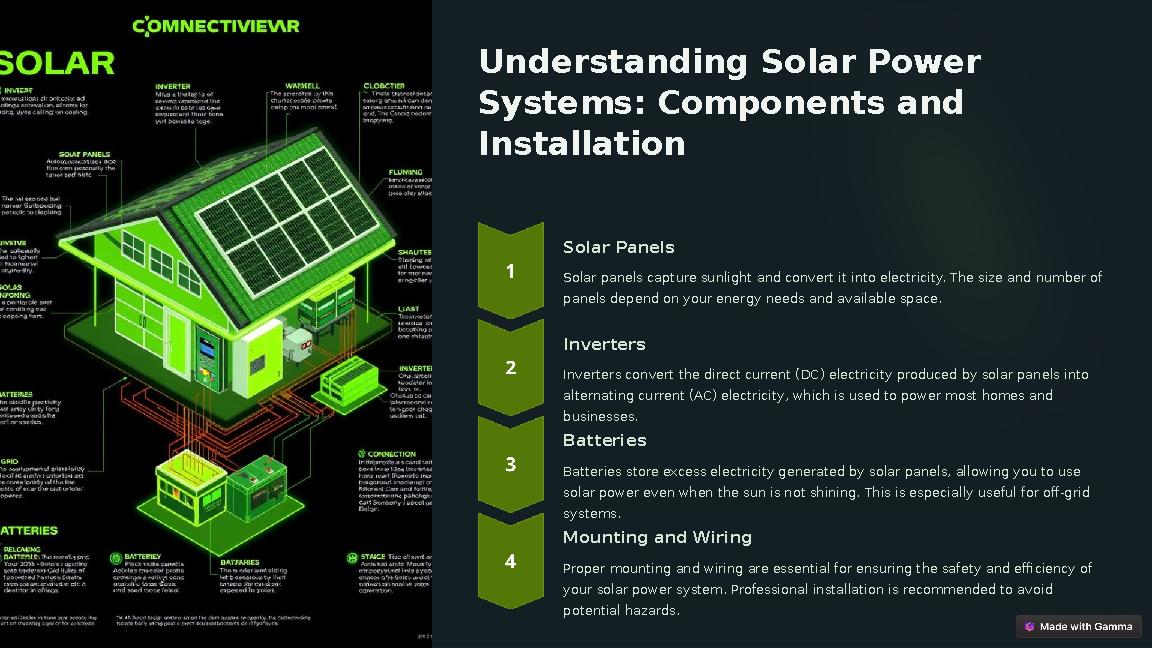
#6 слайд
Understanding Solar Power
Systems: Components and
Installation
Solar Panels
Solar panels capture sunlight and convert it into electricity. The size and number of
panels depend on your energy needs and available space.
Inverters
Inverters convert the direct current (DC) electricity produced by solar panels into
alternating current (AC) electricity, which is used to power most homes and
businesses.
Batteries
Batteries store excess electricity generated by solar panels, allowing you to use
solar power even when the sun is not shining. This is especially useful for off-grid
systems.
Mounting and Wiring
Proper mounting and wiring are essential for ensuring the safety and efficiency of
your solar power system. Professional installation is recommended to avoid
potential hazards.
6 слайд
Understanding Solar Power Systems: Components and Installation Solar Panels Solar panels capture sunlight and convert it into electricity. The size and number of panels depend on your energy needs and available space. Inverters Inverters convert the direct current (DC) electricity produced by solar panels into alternating current (AC) electricity, which is used to power most homes and businesses. Batteries Batteries store excess electricity generated by solar panels, allowing you to use solar power even when the sun is not shining. This is especially useful for off-grid systems. Mounting and Wiring Proper mounting and wiring are essential for ensuring the safety and efficiency of your solar power system. Professional installation is recommended to avoid potential hazards.
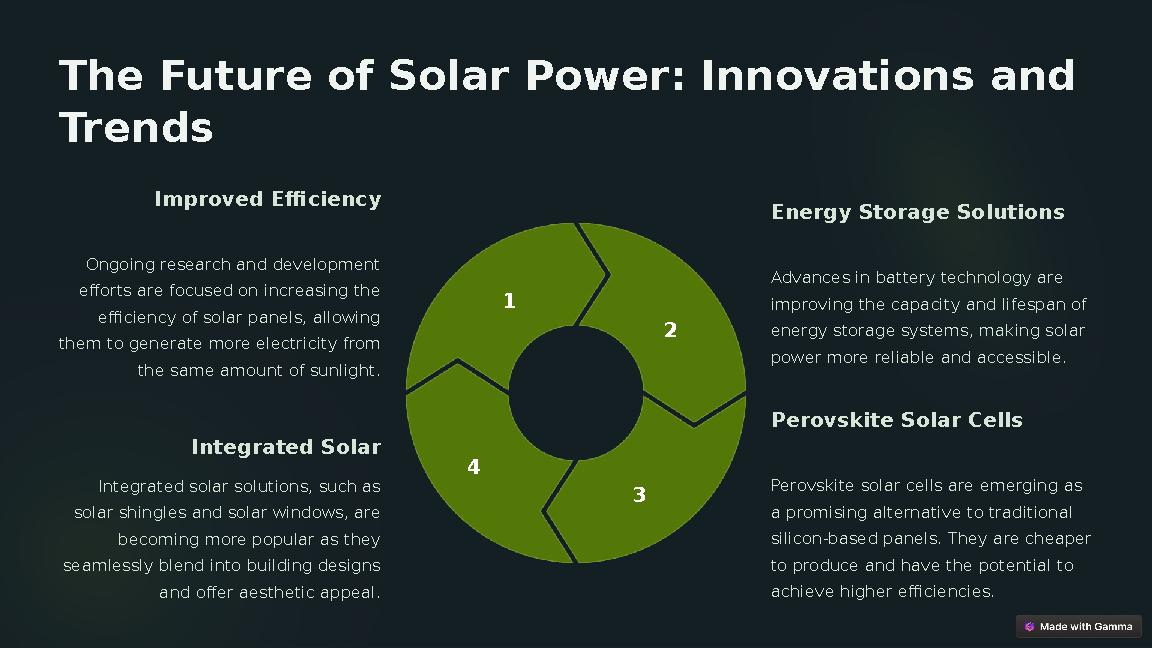
#7 слайд
The Future of Solar Power: Innovations and
Trends
Improved Efficiency
Ongoing research and development
efforts are focused on increasing the
efficiency of solar panels, allowing
them to generate more electricity from
the same amount of sunlight.
1
Energy Storage Solutions
Advances in battery technology are
improving the capacity and lifespan of
energy storage systems, making solar
power more reliable and accessible.
2
Perovskite Solar Cells
Perovskite solar cells are emerging as
a promising alternative to traditional
silicon-based panels. They are cheaper
to produce and have the potential to
achieve higher efficiencies.
3
Integrated Solar
Integrated solar solutions, such as
solar shingles and solar windows, are
becoming more popular as they
seamlessly blend into building designs
and offer aesthetic appeal.
4
7 слайд
The Future of Solar Power: Innovations and Trends Improved Efficiency Ongoing research and development efforts are focused on increasing the efficiency of solar panels, allowing them to generate more electricity from the same amount of sunlight. 1 Energy Storage Solutions Advances in battery technology are improving the capacity and lifespan of energy storage systems, making solar power more reliable and accessible. 2 Perovskite Solar Cells Perovskite solar cells are emerging as a promising alternative to traditional silicon-based panels. They are cheaper to produce and have the potential to achieve higher efficiencies. 3 Integrated Solar Integrated solar solutions, such as solar shingles and solar windows, are becoming more popular as they seamlessly blend into building designs and offer aesthetic appeal. 4
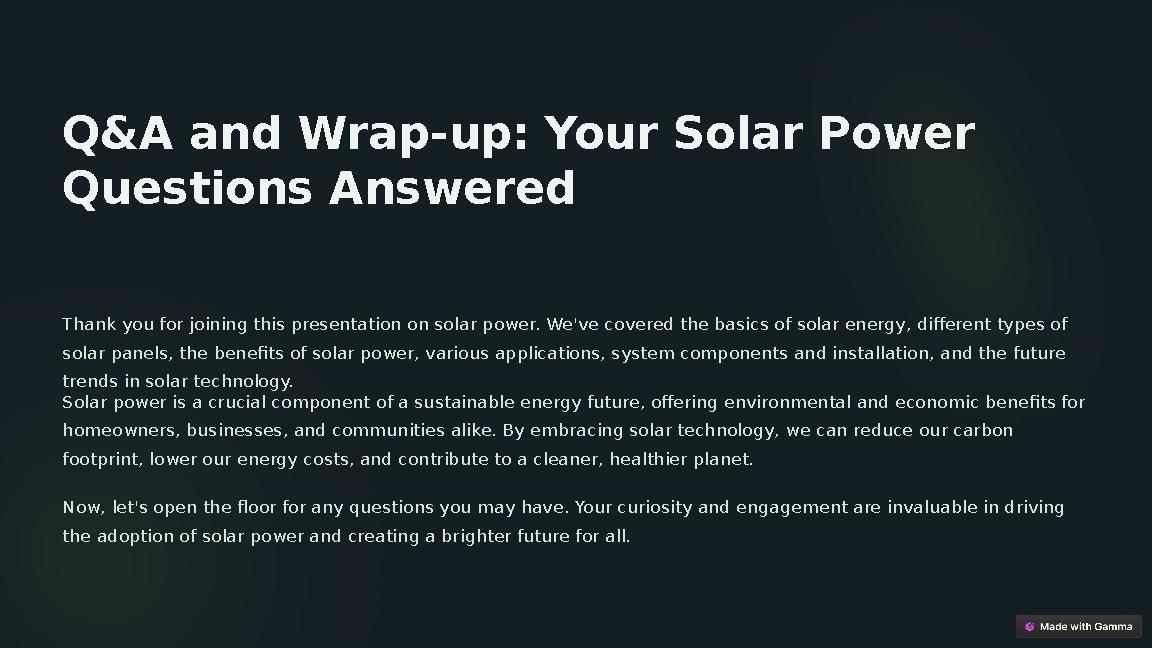
#8 слайд
Q&A and Wrap-up: Your Solar Power
Questions Answered
Thank you for joining this presentation on solar power. We've covered the basics of solar energy, different types of
solar panels, the benefits of solar power, various applications, system components and installation, and the future
trends in solar technology.
Solar power is a crucial component of a sustainable energy future, offering environmental and economic benefits for
homeowners, businesses, and communities alike. By embracing solar technology, we can reduce our carbon
footprint, lower our energy costs, and contribute to a cleaner, healthier planet.
Now, let's open the floor for any questions you may have. Your curiosity and engagement are invaluable in driving
the adoption of solar power and creating a brighter future for all.
8 слайд
Q&A and Wrap-up: Your Solar Power Questions Answered Thank you for joining this presentation on solar power. We've covered the basics of solar energy, different types of solar panels, the benefits of solar power, various applications, system components and installation, and the future trends in solar technology. Solar power is a crucial component of a sustainable energy future, offering environmental and economic benefits for homeowners, businesses, and communities alike. By embracing solar technology, we can reduce our carbon footprint, lower our energy costs, and contribute to a cleaner, healthier planet. Now, let's open the floor for any questions you may have. Your curiosity and engagement are invaluable in driving the adoption of solar power and creating a brighter future for all.

шағым қалдыра аласыз




